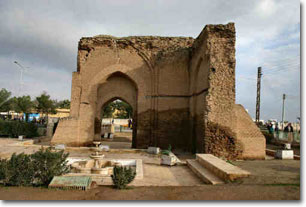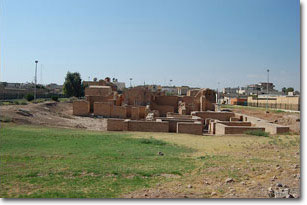|
 193 km
south east of Aleppo, 550 km north east of Damascus, Al Raqqa is said
to be founded by Alexander the Great of Macedonia, although many say
that it might be Seleucos Nicator, Alexander's famous general. It was
given the name Callinicum by Seleucos II Callinicos who established the
center around 244 - 2 BC. 193 km
south east of Aleppo, 550 km north east of Damascus, Al Raqqa is said
to be founded by Alexander the Great of Macedonia, although many say
that it might be Seleucos Nicator, Alexander's famous general. It was
given the name Callinicum by Seleucos II Callinicos who established the
center around 244 - 2 BC.
In the Byzantine era it was considered a very important town, as it was
on the border between Byzantium and Persia. It fell into Muslim hands
in 639 AD and the Umayyad Caliph, Hisham chose the flat land to the
west of the classical town as the site for two palaces. However,
nothing remains of these palaces. The Abbasids rebuilt Al Raqqa
10 years after Baghdad, it was considered a second capital and was
built by Caliph Mansour (ruled 754 - 75) in the same horseshoe plan,
this was a modified version of his earlier circular plan for Baghdad.
It was surrounded by a semi-circular wall, which was extremely thick
and was guarded by many towers. Nearly half a century later Caliph
Haroun Al Rashid built a second and newer Raqqa next to the old one as
a sort of companion. It soon was integrated into the older one. Under the Ayyūbids and the Zengids, the town of Al Raqqa remained of great importance as they had strong links with the Northern Mesopotamian city of Mosul. It became famous in the 12th century for glazed ceramic industry, which was started by Saladin the Ayyūbid leader. In 1258 it was ransacked by the Mongols, and for a long time Al Raqqa
was abandoned to sit quietly on the shores of the Euphrates. In 1960,
Al Raqqa regained its important role with the building of Al Thawra Dam and the Assad reservoir. Al Thawra Dam generates a large percentage of Syria's electricity. The Walls: There have been efforts to build up again the semi-circular baked and
mud brick walls of the Abbasid town of which two thirds of the length
survive. The walls were originally of double thickness, strengthened
every 35 m by more than 100 round towers. Bab Baghdad (Baghdad Gate): In the south eastern corner of the walled city lies the Bab Baghdad
which recent research indicates may date from the mid 12th century. The frieze is patterned blind arches above the gateway. This
decorative brickwork closely followed Mesopotamian styles. Qasr al Banat (Palace of the Maidens): One of the most famous remains of this city. The building is centered
on a courtyard with fountain with an iwan (high arched and open hall)
on each side, all richly ornamented in brick. It dates from the 9th
century and is a rare example outside Iran of the four-iwan plan. The Great Mosque: Also named "Friday Mosque" whose construction was originally undertaken
in 772 under Caliph al Mansour. The courtyard was rebuilt by Nur al
Din. There's the plain tower of 25 m high and part of the courtyard
colonnade in mud-brick Arab arches including the inscription recording
Nur al Din's contribution. The mosque originally had 11 towers around
the periphery. |